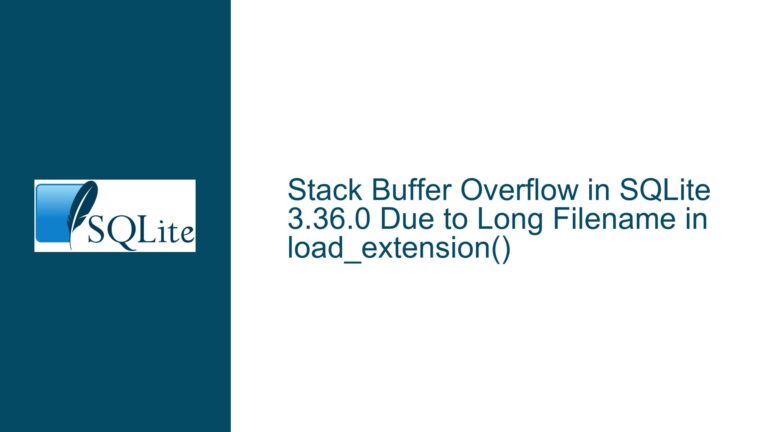Conditionally Executing SQLite Commands Based on Table Existence
Querying sqlite_schema for Conditional Table Existence Checks
The core issue revolves around the need to conditionally execute a set of SQL commands in SQLite based on whether a specific table exists. This is a common requirement when dealing with database migrations, schema transformations, or toggling between different database states. The primary challenge is that SQLite, by design, does not natively support procedural logic or conditional execution within its SQL dialect. However, SQLite provides mechanisms to work around this limitation, primarily through the use of the sqlite_schema (formerly sqlite_master) table, which stores metadata about the database’s schema.
The sqlite_schema table contains columns such as type, name, tbl_name, rootpage, and sql, which describe the objects in the database. By querying this table, you can determine whether a specific table exists and then conditionally execute SQL commands based on the result. This approach is particularly useful when you need to toggle between two database states, such as converting a flat table to a relational schema and vice versa.
For example, if you have a flat table named flat and you want to conditionally execute a set of commands to either convert it to a relational schema or revert it back to the flat structure, you can use the sqlite_schema table to check for the existence of the flat table. If the table exists, you can execute commands to transform it into a relational schema. If it does not exist, you can execute commands to recreate the flat table from the relational schema.
Limitations of SQLite’s Procedural Logic and Workarounds
One of the key limitations of SQLite is its lack of support for procedural logic, such as IF statements or loops, within its SQL dialect. This makes it challenging to implement conditional logic directly in SQLite scripts. However, there are several workarounds that can be employed to achieve conditional execution of SQL commands.
One common workaround is to use external scripting languages, such as Python, to handle the conditional logic and execute the appropriate SQL commands based on the result of a query to the sqlite_schema table. This approach allows you to leverage the full power of a procedural language to implement complex logic while still using SQLite for data storage and retrieval.
Another workaround is to use SQLite’s CREATE TABLE IF NOT EXISTS and DROP TABLE IF EXISTS statements, which allow you to conditionally create or drop tables without causing errors if the table already exists or does not exist. While these statements do not provide full conditional execution, they can be combined with other techniques to achieve the desired behavior.
For example, you can use the CREATE TABLE IF NOT EXISTS statement to ensure that a table exists before executing a set of commands, or use the DROP TABLE IF EXISTS statement to remove a table before recreating it. These statements can be combined with queries to the sqlite_schema table to implement more complex conditional logic.
Implementing Conditional Execution with sqlar and writefile
A more advanced workaround involves using SQLite’s sqlar table and writefile function to conditionally generate and execute SQL scripts based on the existence of a table. The sqlar table is a special table that can be used to store files within the SQLite database, while the writefile function allows you to write data to a file on the filesystem.
To implement conditional execution using this approach, you can store the SQL scripts for each state (e.g., converting the flat table to a relational schema and vice versa) in the sqlar table. You can then use a query to the sqlite_schema table to determine which script to execute based on the existence of the flat table. The writefile function can be used to write the appropriate script to a temporary file, which can then be executed using SQLite’s .read command.
For example, you can create two SQL scripts: script1.sql for converting the flat table to a relational schema, and script2.sql for reverting back to the flat structure. These scripts can be stored in the sqlar table using the .archive command. You can then use a query to the sqlite_schema table to determine which script to execute based on the existence of the flat table. The writefile function can be used to write the appropriate script to a temporary file, which can then be executed using the .read command.
This approach allows you to implement conditional execution of SQL commands within SQLite, even though the database itself does not support procedural logic. It also provides a way to package the SQL scripts within the database itself, making it easier to distribute and execute the scripts on different systems.
Using Views to Dynamically Generate SQL Scripts
Another advanced technique for implementing conditional execution in SQLite is to use views to dynamically generate SQL scripts based on the existence of a table. A view is a virtual table that is defined by a query, and it can be used to generate SQL code that can be executed conditionally.
For example, you can create a view that generates the SQL code for converting the flat table to a relational schema if the flat table exists, or generates the SQL code for reverting back to the flat structure if the flat table does not exist. This view can then be used to generate the appropriate SQL script, which can be written to a temporary file using the writefile function and executed using the .read command.
To implement this approach, you can create a view that uses a CASE statement to determine which SQL script to generate based on the result of a query to the sqlite_schema table. The view can then be used in a query to generate the appropriate SQL script, which can be written to a temporary file and executed.
For example, you can create a view named toggle_script that generates the SQL code for converting the flat table to a relational schema if the flat table exists, or generates the SQL code for reverting back to the flat structure if the flat table does not exist. This view can then be used in a query to generate the appropriate SQL script, which can be written to a temporary file and executed.
This approach provides a more elegant and flexible way to implement conditional execution of SQL commands in SQLite, as it allows you to dynamically generate the SQL code based on the current state of the database. It also eliminates the need to store multiple SQL scripts in the sqlar table, as the SQL code is generated on the fly by the view.
Combining Techniques for Robust Conditional Execution
In practice, you may need to combine several of these techniques to implement robust conditional execution of SQL commands in SQLite. For example, you can use a combination of queries to the sqlite_schema table, the sqlar table, the writefile function, and views to implement complex conditional logic.
For example, you can use a query to the sqlite_schema table to determine whether the flat table exists, and then use a view to generate the appropriate SQL script based on the result. The writefile function can then be used to write the generated SQL script to a temporary file, which can be executed using the .read command.
This approach allows you to implement complex conditional logic within SQLite, even though the database itself does not support procedural logic. It also provides a way to package the SQL scripts within the database itself, making it easier to distribute and execute the scripts on different systems.
Best Practices for Conditional Execution in SQLite
When implementing conditional execution of SQL commands in SQLite, there are several best practices that you should follow to ensure that your solution is robust, maintainable, and efficient.
First, always use the sqlite_schema table to check for the existence of tables or other database objects. This is the most reliable way to determine the current state of the database schema, and it allows you to implement conditional logic based on the presence or absence of specific objects.
Second, consider using external scripting languages, such as Python, to handle complex conditional logic. While SQLite does not support procedural logic within its SQL dialect, you can use an external script to implement the logic and execute the appropriate SQL commands based on the result of a query to the sqlite_schema table.
Third, use SQLite’s CREATE TABLE IF NOT EXISTS and DROP TABLE IF EXISTS statements to avoid errors when creating or dropping tables. These statements allow you to conditionally create or drop tables without causing errors if the table already exists or does not exist.
Fourth, consider using the sqlar table and writefile function to package and execute SQL scripts within the database itself. This approach allows you to distribute the SQL scripts along with the database, making it easier to execute the scripts on different systems.
Finally, use views to dynamically generate SQL scripts based on the current state of the database. This approach provides a more elegant and flexible way to implement conditional execution of SQL commands, as it allows you to generate the SQL code on the fly based on the result of a query to the sqlite_schema table.
By following these best practices, you can implement robust and maintainable solutions for conditional execution of SQL commands in SQLite, even though the database itself does not support procedural logic.






